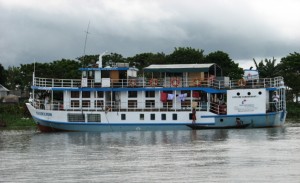Earth Sciences115
-

Joining the Kokilmoni
After a great field season last winter, we had an extraordinary opportunity this fall, a research cruise on the Bangladeshi rivers collecting geophysical data. We are using the same technique that Lamont uses on its ship, the R/V Marcus Langseth, but a mini version. The basic idea is to use sound waves from bursts of…
-

A Sea Change, Deep Under Antarctic Waters
The frigid seabottom off Antarctica holds a surprising riot of life: colorful carpets of sponges, starfish, sea cucumbers and many other soft, bottom-dwelling animals, shown on images from robotic submarines. Now, it appears that many such communities could fast disappear, due to warming climate. Scientists sailing on an icebreaker last year have just published a study showing that gigantic…
-
Humans Shaped Stone Axes 1.8 Million Years Ago, Study Says
Evidence Pushes Advanced Tool-Making Methods Back in Time
-

Track the Number of People in Irene’s Path
As Hurricane Irene barrels up the East Coast, the number of people affected is rising. Based on calculations at 2 pm on Saturday, more than 47 million people were within 100 miles of the storm track; and nearly 69 million within 200 miles, according to Columbia’s Center for International Earth Science Information Network(CIESIN). Visit CIESIN’s…
-

Live, from the Bottom of the Sea
Lamont-Doherty scientist Timothy Crone is at sea off the Northwest U.S. coast, dropping sensors into the deep ocean as part of a major initiative to better understand oceans, climate and plate tectonics. Watch a live video feed from the latest dive at 3 p.m. EST.
-

Magnitude 5.8 Quake Rattles East Coast
The magnitude 5.8 earthquake that shook central Virginia on Tuesday afternoon is one of the biggest earthquakes to hit the East Coast since 1897, and was comparable in strength to a quake on the New York-Canadian border in 1944, according to the U.S. Geological Survey. It was centered near Mineral, Va., about 38 miles northwest…
-

Tree Rings, Ecology and Culture in Mongolia
“How do you know when you are in wilderness? When you have walked beyond where most people walk, when you have left the road … when the easiest route to walk is not a path tread by people but rather the path tread by wolves, moose and deer.”
-

Hydraulic Fracturing: Resources for Journalists
(Updated Feb. 12, 2019) Earth Institute scientists can offer a wide range of expertise to journalists covering natural-gas production using hydraulic fracturing (hydrofracking). This includes basics of energy exploration and extraction; rock mechanics; contaminants in underground water; manmade earthquakes; and economic/political questions surrounding the practice. Here is a brief guide. (Click on hyperlinks for individual…
-

Atmospheric Scientists Win Early Career Awards
Two scientists at Lamont-Doherty Earth Observatory have been recognized for early-career achievement in the atmospheric sciences by the American Geophysical Union (AGU), the world’s largest earth-sciences organization. Tiffany Shaw, 31, is a physicist who uses computer models and mathematical equations to study the basic dynamics of the atmosphere and climate, for instance, how the jet…

AGU25, the premier Earth and space science conference, takes place December 15-19, 2025 in New Orleans, Louisiana. This year’s theme—Where Science Connects Us—puts in focus how science depends on connection, from the lab to the field to the ballot box. Once again, Lamont-Doherty Earth Observatory and Columbia Climate School scientists, experts, students, and educators are playing an active role, sharing our research and helping shape the future of our planet. #AGU25 Learn More
